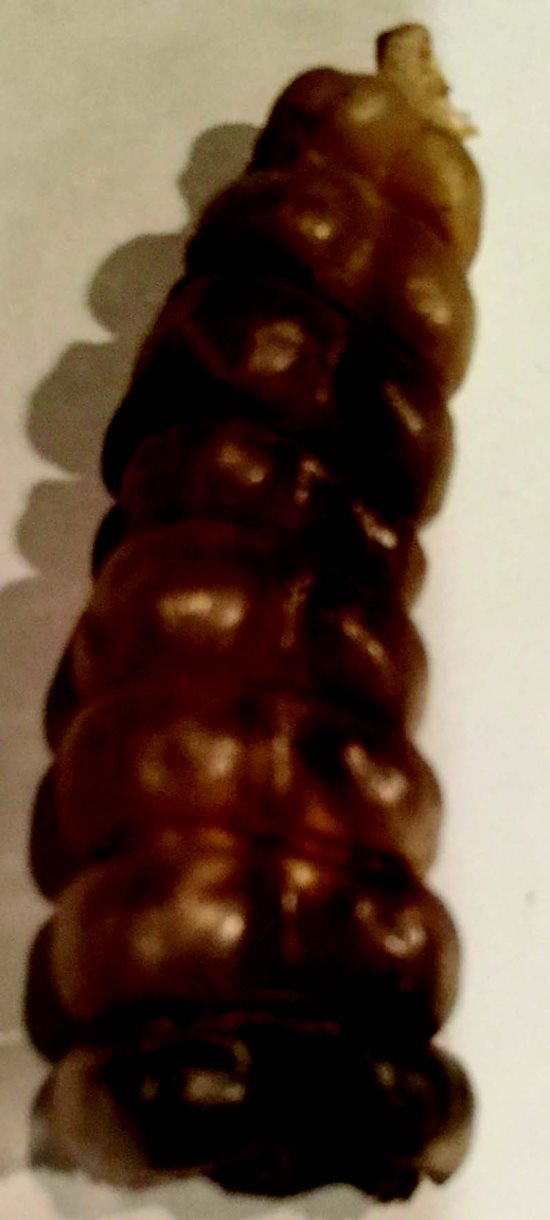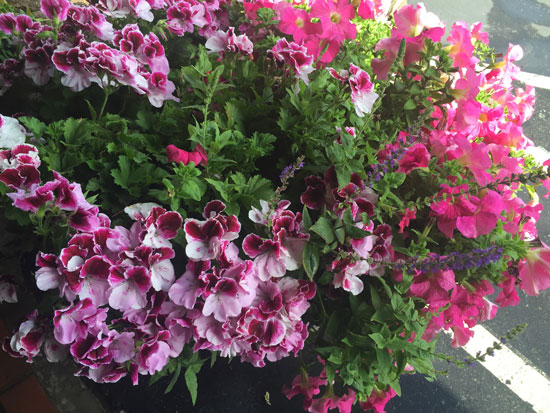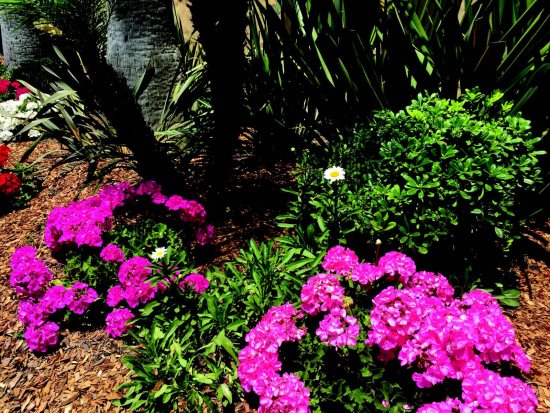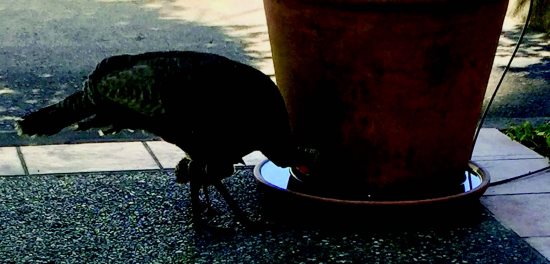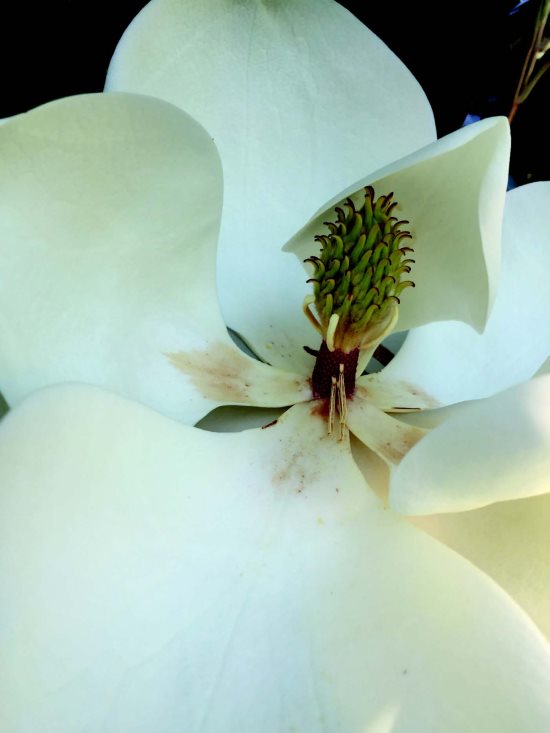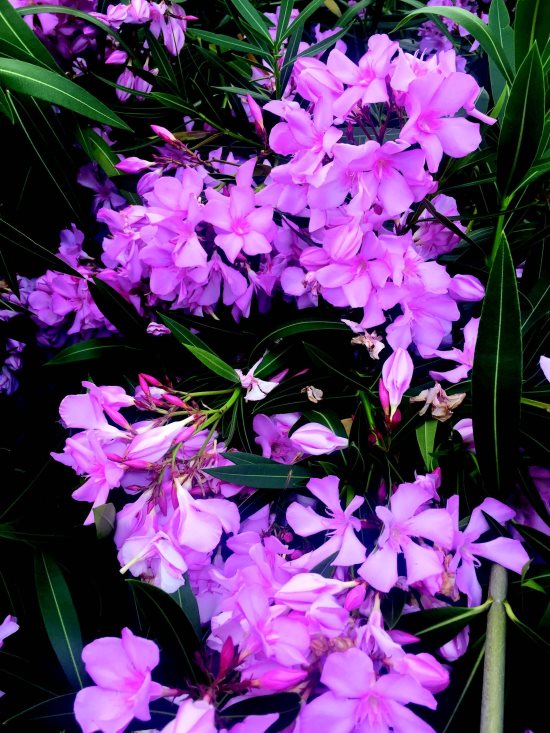 |
|
|
Oleanders repel gophers and moles. Photos Cynthia Brian
|
|
|
|
|
|
"There's a snake lurking in the grass." Virgil
 Ten rattles! Diamond pattern on the skin. This was no gopher snake!
Ten rattles! Diamond pattern on the skin. This was no gopher snake!
 I was checking my orchard on the hill agonizing over the gopher mounds when I saw the slithering snake. Excited to know that I had a friend in the rodent business, I quickly ran to get a closer look. Dang! Not a gopher snake but crotalus oreganus oreganus-northern Pacific rattlesnake. I was wearing my normal summer gardening gear - shorts, bathing suit top, cowboy hat and boots. Not exactly the suggested outfit for wrangling a rattler. As I was counting the number of rattles, he/she slinked into the rosemary bush bordering my vegetable garden.
I was checking my orchard on the hill agonizing over the gopher mounds when I saw the slithering snake. Excited to know that I had a friend in the rodent business, I quickly ran to get a closer look. Dang! Not a gopher snake but crotalus oreganus oreganus-northern Pacific rattlesnake. I was wearing my normal summer gardening gear - shorts, bathing suit top, cowboy hat and boots. Not exactly the suggested outfit for wrangling a rattler. As I was counting the number of rattles, he/she slinked into the rosemary bush bordering my vegetable garden.
 It's been over five years since I've witnessed a rattlesnake on my property. According to the experts, because of the wet winter and now the dry summer, rats, mice, gophers and voles are ubiquitous, which means that their hunters are in abundance as well. This season I've had several gopher, garter, and king snakes as wanted guests. Rattlesnakes give me the shivers.
It's been over five years since I've witnessed a rattlesnake on my property. According to the experts, because of the wet winter and now the dry summer, rats, mice, gophers and voles are ubiquitous, which means that their hunters are in abundance as well. This season I've had several gopher, garter, and king snakes as wanted guests. Rattlesnakes give me the shivers.
 Every summer growing up on our ranch in Napa County meant a meeting with at least 50 or more rattlers. I've stepped on a few in the past and a couple snaked over the top of my boots. Fortunately neither I, nor anyone in my family has ever suffered a bite.
Every summer growing up on our ranch in Napa County meant a meeting with at least 50 or more rattlers. I've stepped on a few in the past and a couple snaked over the top of my boots. Fortunately neither I, nor anyone in my family has ever suffered a bite.
 Rattlesnakes are the only pit viper found in California. All are poisonous and potentially dangerous. They kill their prey with their venom as opposed to constriction. Babies are born fully developed with one rattle and are even more potent than adults. The rattles on the end of the snake's tail are used as a warning system, alerting predators or humans to stay away. Every time the snake sheds, a new rattle is grown. Rattles can break off, and to the unaccustomed bystander, a snake without rattles may resemble a gopher snake. Without proper identification, never handle a snake in the grass. Rattlesnakes are not aggressive and don't usually strike unless provoked, however, since they seek warm-blooded prey, a human could be mistaken as food.
Rattlesnakes are the only pit viper found in California. All are poisonous and potentially dangerous. They kill their prey with their venom as opposed to constriction. Babies are born fully developed with one rattle and are even more potent than adults. The rattles on the end of the snake's tail are used as a warning system, alerting predators or humans to stay away. Every time the snake sheds, a new rattle is grown. Rattles can break off, and to the unaccustomed bystander, a snake without rattles may resemble a gopher snake. Without proper identification, never handle a snake in the grass. Rattlesnakes are not aggressive and don't usually strike unless provoked, however, since they seek warm-blooded prey, a human could be mistaken as food.
 Rodents are inundating homes and gardens this year in search of water and food. Wherever rodents race, snakes that eat rodents follow. I discovered a terrific trap that zaps rats and mice dead. It's called The Rat Zapper and it works like a charm.
Rodents are inundating homes and gardens this year in search of water and food. Wherever rodents race, snakes that eat rodents follow. I discovered a terrific trap that zaps rats and mice dead. It's called The Rat Zapper and it works like a charm.
 For gophers, box traps and black hole traps work best. The moles are normally looking for grubs in a lawn and don't do much damage. I just stomp down on their ridges. Voles, also called "field mice" or meadow mice" are bad news as they target the root systems of vegetable gardens, lawns and fruit orchards. They will gnaw at the trunks of trees and shrubs, chew blades and stems of grass, and eat bulbs. They often use empty mole or gopher burrows as their runways. Voles reproduce rapidly leading to mass destructions of landscapes. Snap traps are best to catch these critters when they exit their holes.
For gophers, box traps and black hole traps work best. The moles are normally looking for grubs in a lawn and don't do much damage. I just stomp down on their ridges. Voles, also called "field mice" or meadow mice" are bad news as they target the root systems of vegetable gardens, lawns and fruit orchards. They will gnaw at the trunks of trees and shrubs, chew blades and stems of grass, and eat bulbs. They often use empty mole or gopher burrows as their runways. Voles reproduce rapidly leading to mass destructions of landscapes. Snap traps are best to catch these critters when they exit their holes.
 The best protection to minimize the rodent infestation is to invite their natural predators - owls, hawks, and yes, snakes. A family of barn owls will hunt and eat up to 1,000 rodents a year. Consider installing a nesting box for owls. The hawks fly with the wind currents to find the rodent restaurant.
The best protection to minimize the rodent infestation is to invite their natural predators - owls, hawks, and yes, snakes. A family of barn owls will hunt and eat up to 1,000 rodents a year. Consider installing a nesting box for owls. The hawks fly with the wind currents to find the rodent restaurant.
 Most snakes to visit our gardens are not venomous, yet, all snakes can bite and should not be handled. King snakes are my very favorite snake to have in a garden because they kill rattlesnakes.
Most snakes to visit our gardens are not venomous, yet, all snakes can bite and should not be handled. King snakes are my very favorite snake to have in a garden because they kill rattlesnakes.
 The California Department of Fish and Wildlife suggests the following precautions since rattlesnakes do not just reside in rural areas. We live in hill country with plenty of open space, creeks, and trails. Rattlesnakes are here. Pay attention.
The California Department of Fish and Wildlife suggests the following precautions since rattlesnakes do not just reside in rural areas. We live in hill country with plenty of open space, creeks, and trails. Rattlesnakes are here. Pay attention.
 Be alert when walking in a park, golf course or riverbank.
Be alert when walking in a park, golf course or riverbank.
 Wear sturdy boots and don't wear flip-flops when hiking. Stay on the trail and don't wander into the brush. Inform your children to stay with you.
Wear sturdy boots and don't wear flip-flops when hiking. Stay on the trail and don't wander into the brush. Inform your children to stay with you.
 Avoid tall brush, woodpiles, and underbrush. Snakes often hide during the heat of the day; they come out at dusk and dawn to hunt.
Avoid tall brush, woodpiles, and underbrush. Snakes often hide during the heat of the day; they come out at dusk and dawn to hunt.
 Check your sleeping bag when camping, step on rocks and logs instead of climbing over them.
Check your sleeping bag when camping, step on rocks and logs instead of climbing over them.
 Watch where you step when leaving your house or a building. Rattlesnakes often stretch out at door thresholds.
Watch where you step when leaving your house or a building. Rattlesnakes often stretch out at door thresholds.
 Rattlesnakes swim. Don't grab onto floating sticks or branches when swimming anywhere, including your swimming pool.
Rattlesnakes swim. Don't grab onto floating sticks or branches when swimming anywhere, including your swimming pool.
 Don't put your hand into a place you can't see. Don't weed under bushes unless you've rattled the area.
Don't put your hand into a place you can't see. Don't weed under bushes unless you've rattled the area.
 A dead rattlesnake is still venomous. The head needs to be buried.
A dead rattlesnake is still venomous. The head needs to be buried.
 If you have a dog, talk to your veterinarian about getting the canine rattlesnake vaccine. For small dogs, it doesn't always work, but for a large dog, it could be life saving.
If you have a dog, talk to your veterinarian about getting the canine rattlesnake vaccine. For small dogs, it doesn't always work, but for a large dog, it could be life saving.
 Hire a snake wrangler if you find an unwanted snake. Check online.
Hire a snake wrangler if you find an unwanted snake. Check online.
 In case of a rattlesnake bite, call Poison Control immediately at 800-222-1222 and get to the nearest emergency room. Stay calm, remove rings, and don't try to suck the venom, cut the wound, tourniquet the bite or ice it. Most rattlesnake bites are accidental, but all are very dangerous, and can be fatal.
In case of a rattlesnake bite, call Poison Control immediately at 800-222-1222 and get to the nearest emergency room. Stay calm, remove rings, and don't try to suck the venom, cut the wound, tourniquet the bite or ice it. Most rattlesnake bites are accidental, but all are very dangerous, and can be fatal.
 I still haven't found my rattlesnake but I am being extra cautious, especially when weeding, wearing my boots, gloves, and carrying a sharp shovel. As much as I despise rats and other rodents, a rattlesnake is not a welcome serpent in my summer paradise where I prefer to be barefoot and bikini clad!
I still haven't found my rattlesnake but I am being extra cautious, especially when weeding, wearing my boots, gloves, and carrying a sharp shovel. As much as I despise rats and other rodents, a rattlesnake is not a welcome serpent in my summer paradise where I prefer to be barefoot and bikini clad!
 Enjoy the summer and join me in my dance to stay clear of the rats, rattles and voles!
Enjoy the summer and join me in my dance to stay clear of the rats, rattles and voles!
 Cynthia Brian's Summer Tips:
Cynthia Brian's Summer Tips:
 The following plants are repellents to gophers and moles. Plant them in areas of infestation.
The following plants are repellents to gophers and moles. Plant them in areas of infestation.

 Rosemary
Rosemary
 Marigold
Marigold
 Oleander
Oleander
 Penstemon
Penstemon
 Catmint
Catmint
 Salvia
Salvia
 Strawberry
Strawberry
 Daffodil
Daffodil
 Castor Bean
Castor Bean

 Garden Events
Garden Events

 If you will be in Europe in September you may want to visit the spoga+gafa, the world's leading garden trade fair Sept. 3-5 in Cologne, Germany with over 2,000 exhibitors from 60 countries. http://ow.ly/pBxP30dA88D
If you will be in Europe in September you may want to visit the spoga+gafa, the world's leading garden trade fair Sept. 3-5 in Cologne, Germany with over 2,000 exhibitors from 60 countries. http://ow.ly/pBxP30dA88D

 The World's Pure Food Fair and National Heirloom Expo happens in Santa Rosa Sept. 5, 6,and 7 with three-day tickets only $25. Heritage poultry, music, seeds, fruit tastings, dahlia show, colossal pumpkins and more. http://www.theheirloomexpo.com
The World's Pure Food Fair and National Heirloom Expo happens in Santa Rosa Sept. 5, 6,and 7 with three-day tickets only $25. Heritage poultry, music, seeds, fruit tastings, dahlia show, colossal pumpkins and more. http://www.theheirloomexpo.com

 Closer to home, Moraga Gardens Farm, a nonprofit volunteer membership garden, 1290 Moraga Way, Moraga between the fire station and School Street grows many varieties of pesticide-free, organic vegetables including tomatoes, eggplants, peppers, cucumbers, chard, fruits and herbs. Watch for demonstrations, lectures and sales. https://moragagardensfarm.org
Closer to home, Moraga Gardens Farm, a nonprofit volunteer membership garden, 1290 Moraga Way, Moraga between the fire station and School Street grows many varieties of pesticide-free, organic vegetables including tomatoes, eggplants, peppers, cucumbers, chard, fruits and herbs. Watch for demonstrations, lectures and sales. https://moragagardensfarm.org

 Blooming Beautiful!
Blooming Beautiful!

 Roses
Roses
 Gladioli
Gladioli
 Firecracker Plants
Firecracker Plants
 Snapdragons
Snapdragons
 Magnolias
Magnolias
 Petunias
Petunias
 Pelargoniums
Pelargoniums
 Geraniums
Geraniums
 Daisies
Daisies
 Yarrow
Yarrow
 Hollyhocks
Hollyhocks
 Osteospermums
Osteospermums


 Happy Gardening and Happy Growing!
Happy Gardening and Happy Growing!


|

